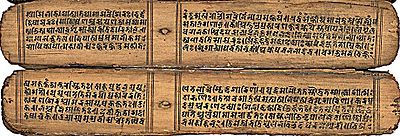
Bhujimol
Encyclopedia

Nepal script
Nepal script is a group of scripts that developed from the Brahmi script and are used primarily in Nepal Bhasa. It is also used to write Sanskrit.-Scripts based on Nepal script:The scripts are as follows-*Ranjana script...
. It is used to write Nepal Bhasa
Nepal Bhasa
Nepal Bhasa is one of the major languages of Nepal, and is also spoken in India, particularly in Sikkim where it is one of the 11 official languages. Nepal Bhasa is the mother tongue of about 3% of the people in Nepal . It is spoken mainly by the Newars, who chiefly inhabit the towns of the...
.
Etymology
The word "Bhujimol" comes from Nepalbhasa words "bhuji" meaning housefly and "mol" a word written at the end of scripts (eg-Litumol, Golmol).Recent findings
In 2003, a brick was discovered in Kathmandu, in the course of reconstruction of the Dhando ChaityaChaitya
A chaitya is a Buddhist or Jain shrine including a stupa. In modern texts on Indian architecture, the term chaitya-griha is often used to denote assembly or prayer hall that houses a stupa.-History:...
, bearing inscriptions in both Brahmi
Brāhmī script
Brāhmī is the modern name given to the oldest members of the Brahmic family of scripts. The best-known Brāhmī inscriptions are the rock-cut edicts of Ashoka in north-central India, dated to the 3rd century BCE. These are traditionally considered to be early known examples of Brāhmī writing...
and Bhujimol: The upper face is inscribed with Cha Ru Wa Ti in Brahmi, and with Cha Ru Wa Ti Dhande / He Tu Pra Bha in the Newari Bhujimol script. There are Swastika
Swastika
The swastika is an equilateral cross with its arms bent at right angles, in either right-facing form in counter clock motion or its mirrored left-facing form in clock motion. Earliest archaeological evidence of swastika-shaped ornaments dates back to the Indus Valley Civilization of Ancient...
marks at the two ends of the upper face with a Chakra
Chakra
Chakra is a concept originating in Hindu texts, featured in tantric and yogic traditions of Hinduism and Buddhism. Its name derives from the Sanskrit word for "wheel" or "turning" .Chakra is a concept referring to wheel-like vortices...
mark in between. The brick measures 35.5 cm x 23 cm x 7 cm and weighs 8.6 kg. The brick may date to as early as the 3rd century BC. The previously earliest known inscription in the Kathmandu valley dated to the 6th century, at the Changu Narayan in Mandeva. The inscription is interpreted to refer to Charumati, a daughter of king Ashoka
Ashoka
Ashok Maurya or Ashoka , popularly known as Ashoka the Great, was an Indian emperor of the Maurya Dynasty who ruled almost all of the Indian subcontinent from ca. 269 BC to 232 BC. One of India's greatest emperors, Ashoka reigned over most of present-day India after a number of military conquests...
's.

